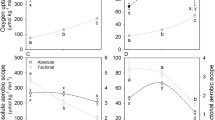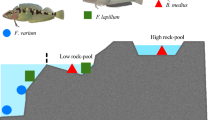Abstract
The cold-stenothermal freshwater gadid Lota lota inhabiting the potamic regions of lowland rivers in central Europe, is exposed to summer temperatures up to 25 °C, which is far above the thermal preferendum of this species. Oxygen consumption rates, determined in field catches sampled at different times of the year, revealed that the basal metabolic rate is depressed during summer when water temperatures are high (152±16 μmol O2 100 g−1 h−1at 22 °C in July compared to 250±33 μmol O2 100 g−1 h−1 at 6 °C in November). This observation led us to investigate whether the observed depression of the metabolic rate is caused by oxygen limitation due to thermal impairment of the ventilatory system, as has been observed in other species. Determination of anaerobic end products (lactate and succinate) in the liver tissue of fish caught at different sampling dates did not show an accumulation of anaerobic end products during the summer, indicating no oxygen limitation. Measurements of enzyme activities in the white musculature and liver suggest that enzymes involved in aerobic metabolism were down-regulated during summer, which may have contributed to the observed reduction of metabolic rate.






Similar content being viewed by others
Abbreviations
- CS :
-
citric synthase
- LDH :
-
lactate dehydrogenase
- PK :
-
pyruvate kinase
- TCA :
-
trichloroacetic acid
References
Beamish FWH (1964) Respiration of fishes with special emphasis on standard oxygen consumption. II. Influence of weight and temperature on respiration of several species. Can J Zool 42:177–188
Bergmeyer HU (1985) Methods of enzymatic analysis (3rd edn). Chemie, Weinheim, Germany
Chih CP, Ellington WR (1986) Control of glycolysis during contractile activity in the phasic adductor muscle of the bay scallop, Agropecten irradians concentricus: identification of potential sites of regulation and a consideration of the control of octopine dehydrogenase activity. Physiol Zool 59:563–573
Farrel AP (1996) Effects of temperature on cardiovascular performance. In: CM Wood, DG McDonald (eds) Global warming: implications for freshwater and marine fish. Cambridge Universtity Press, pp 135–158
Frederich M, Pörtner HO (2000) Oxygen limitation of thermal tolerance defined by cardiac and ventilatory performance in the spider crab Maja squinado. Am J Physiol 279:R1531–R1538
Guderley H (1990) Functional significance of metabolic responses to thermal acclimation in fish muscle. Am J Physiol 259:R245–R252
Guderley H, Foley L (1990) Anatomic and metabolic responses to thermal acclimation in the ninespine stickleback, Pungitius pungitius. Fish Biochem Physiol 8:465–473
Guderley H, Gawlicka A (1992) Qualitative modification of muscle metabolic organization with thermal acclimation of rainbow trout, Oncorhynchus mykiss. Fish Physiol Biochem 10:123–132
Hardwig I, van Dijk PLM, Pörtner HO (1998) High energy turnover at low temperatures: recovery from exhaustive exercise in Antarctic and temperate eelpouts. Am J Physiol 274:R1789–R1796
Hofmann N, Fischer P (2002) Temperature preferences and critical thermal limits of burbot: implications for habitat selection and ontogenetic habitat shift. Trans Am Fish Soc 131:1164–1172
Johnston IA, Dunn JF (1987) Temperature acclimation and metabolism in ectotherms with particular reference to teleost fish. In: Bowler K, Fuller BJ (eds) Symp Soc Exp Biol 41:67–93
Johnston IA, Sidell BD, Driedzic WR (1985) Force-velocity characteristics and metabolism of carp muscle fibers following temperature acclimation. J Exp Biol 119:239–249
Kleckner NW, Sidell BD (1985) Comparison of maximal activities of enzymes from tissues of thermally acclimated and naturally acclimatized chain pickerel (Esox niger). Physiol Zool 58:18–28
Lelek A (1987) The freshwater fishes of Europe. Aula, Wiesbaden
Mark FC, Bock C, Pörtner HO (2002) Oxygen limited thermal tolerance in Antarctic fish investigated by MRI and 31P-MRS. Am J Physiol 283:R1254–R1262
Moon TW, Foster GD (1995) Tissue carbohydrate metabolism, gluconeogenesis and hormonal and environmental influences. In: Hochachka PW, Mommsen TM (eds) Biochemistry and molecular biology of fishes, 4: metabolic biochemistry. Elsevier, New York, pp 65–100
Newsholme EA, Crabtree B (1979) Theoretical principles in the approaches to control of metabolic pathways and their application to glycolysis in muscle. Mol Cell Cardiol 11:839–856
Pääkkönen JPJ, Myyrä R, Marjomäki TJ (1999) The effect of meal size on the rate of gastric evacuation of burbot, Lota lota (L.). Ecol Fresh Water Fish 8:49–54
Peck LS, Pörtner HO, Hardewig I (2002) Metabolic demand, oxygen supply, and critical temperatures in the Antarctic bivalve Laternula elliptica. Physiol Biochem Zool 75:123–133
Pelletier D, Guderley H, Dutil J-D (1993) Effects of growth rate, temperature, season, and body size on glycolytic enzyme activities in the white muscle of atlantic cod (Gadus morhua). J Exp Zool 265:477–487
Pörtner HO (2001) Climate change and temperature dependent biogeography: oxygen limitation of thermal tolerance in animals. Naturwissenschaften 88:137–146
Pörtner HO (2002) Climate change and temperature dependent biogeography: systemic to molecular hierarchies of thermal tolerance in animals. Comp Biochem Physiol A 132:739–761
Pörtner HO, van Dijk PLM, Hardewig I, Sommer A (2000) Levels of metabolic cold adaptation: tradeoffs in eurythermal and stnothermal ectotherms. In: Davison W, Howard Williams C, Broady P (eds) Antarctic ecosystems: models for wider ecological understanding. Caxton, Christchurch, pp 109–122
Tiitu V, Vornanen M (2002) Regulation of cardiac contractility in a cold stenothermal fish, the burbot Lota lota L. J Exp Biol 205:1597–1606
Shodjai F (1980) Entwicklungs- Stoffwechsel- und ernährungsphysiologische Untersuchungen an der Aalquappe (Lota lota L.) unter Berücksichtigung ihrer Eignung ALS Kulturfish. PhD Thesis, University of Kiel, Germany
van Dijk PLM, Tesch C, Hardewig I, Pörtner HO (1999) Physiological disturbances at critically high temperatures. A comparison between stenothermal Antarctic, and eurythermal temperate eelpouts (Zoarcidae). J Exp Biol 202:3611–3622
Wieser W, Krumschnabel G, Ojwang-Okwor JP (1992) The energetics of starvation and growth after refeeding in juveniles of three cyprinid species. Environ Biol Fish 33:63–71
Acknowledgements
We thank T. Hirse for analysis of succinate and malate in the liver tissue samples. Enzyme activities were determined by G. Schmidt, which is gratefully acknowledged. Special thanks to K. Kuntze, who carried out the respiratory measurements and additional analysis; she supported this work with her skilful technical assistance. The experiments carried out in this study comply with current German law.
Author information
Authors and Affiliations
Corresponding author
Additional information
Communicated by G. Heldmaier
Rights and permissions
About this article
Cite this article
Hardewig, I., Pörtner, H.O. & van Dijk, P. How does the cold stenothermal gadoid Lota lota survive high water temperatures during summer?. J Comp Physiol B 174, 149–156 (2004). https://doi.org/10.1007/s00360-003-0399-8
Accepted:
Published:
Issue Date:
DOI: https://doi.org/10.1007/s00360-003-0399-8




